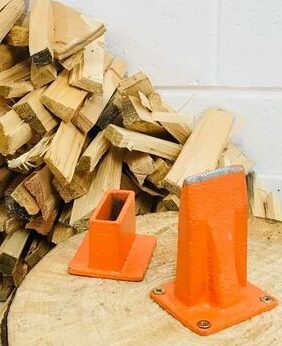Firewood Mastery: A Complete Guide to Fireplace Lighting
Imagine lying on a comfy sofa with a raging fire providing warmth and comfort. Before enjoying this winter splendour, you must understand how to master firewood. Choosing the suitable firewood master is crucial to getting the most out of your stove, even if it may seem like any old piece of wood would suffice. This comprehensive book will help you navigate the firewood world for optimal efficiency, safety, and a delightful fireside experience.
Understanding Firewood Mastery Types to Choose the Best Fuel
Not all firewood Mastery is the same. Their other qualities determine how different kinds of wood burn and how much heat they emit. To pick the correct gasoline, you must first grasp these distinctions. The main firewood varieties include hardwood and softwood. These are some of their primary differences. Its density and weight make it burn slower but create more heat. This makes it ideal for lengthy campfire evenings since the heat lasts. Examples include oak, maple, and hickory. It burns quicker at moderate heat, splits easily, and is lighter. This makes them ideal for starting fires or warming up rapidly. Examples include pine, fir, and cedar.
Discovering what makes widespread firewood mastery exceptional
Each wood offers advantages, not only the vast groupings. Its hallmarks are its lengthy burn period, high heat output, and pleasant scent. A long burn period, moderate heat, and a tinge of sweetness make it popular. Its long burn period, powerful smoke fragrance, and excellent heat output make it popular. It burns swiftly, emits heat, and has lovely white bark. It burns slowly and evenly without much smoke, so people appreciate it. You pick based on your preferences. Wood provides long-lasting warmth. Start a softwood fire quickly for optimal results. Request assistance from local firewood mastery suppliers. They may recommend local kinds, depending on your requirements and the weather.
Perfecting everything: why and how to season firewood mastery
Unused firewood mastery acts like a wet sponge when lit. Freshly cut wood is too wet to burn correctly, producing several issues. Wet wood is difficult to ignite and must be pushed repeatedly, challenging fires. Unaged wood burns cooler and produces more smoke. Fuel is wasted. Wet wood doesn’t burn completely, producing creosote. This might clog your chimney and increase chimney fires. Because of this, firewood must age before igniting. Seasoning involves letting the wood dry naturally to 15–20% moisture. This method enhances burning. Seasoned wood burns quicker and hotter with less smoke. This saves gasoline and cleans the air. Seasoned wood burns better and produces less smoke, reducing chimney creosote.
How to Season Perfectly: Tips for Drying
Seasoning firewood mastery takes 6–12 months, depending on the kind, temperature, and storage. Here are two excellent methods. Split logs are traditionally placed in a single layer in an open, airy space. Cover the stack’s top to keep it dry in rain or snow, but allow side gaps for airflow. This speedier approach uses a controlled oven to dry firewood. Kiln-dried firewood mastery is expensive and complicated, but it dries quickly (a few days). Use a moisture metre or the “crack test” to achieve accurate readings: two pieces of seasoned wood create a loud cracking sound when smacked together, whereas unseasoned wood makes a soft thud.
Choose softwood for effective burning.
Softwood lights are more accessible than hardwood but require a different approach. Popular softwoods include pine, spruce, and fir. To burn each effectively, you need to know these things. Know how quickly softwood burns and the risk of sparks to use it safely in your fireplace. Seasoning firewood mastery involves drying off its moisture. This improves fuel combustion and prevents chimney smoke and creosote. Seasoned food must be kept appropriately to maintain minimal humidity. Keep your firewood in a safe, well-ventilated place for cosy flames—the quantity of your firewood matters, and finding the correct length and breadth will keep the burn even and under control, so you’ll only need to make alterations occasionally. Suitable hand or machine-cutting procedures provide consistent firewood sizes. This makes wood easier to handle and burn better.
Seasonal Firewood Mastery Storage Tips
Keeping it requires year-round effort. When building a fire, you should store your firewood in a weatherproof storage area with sufficient air circulation. Pests and rot rapidly degrade firewood mastery. Raising the wood and inspecting it regularly helps prevent shocks. If you are looking to DIY your firewood storage, building your firewood rack is a great way to make it uniquely yours. To build a sturdy rack, plan and select appropriate materials. A step-by-step tutorial helps you create a solid rack that fits your area and works effectively, whether you use old wood or new components. Starting a fire requires expertise. You may begin a long-lasting fire using wood and newspaper adequately stacked. Lack of patience makes fire-starting more challenging. Patience and moderate fire growth will provide a more steady and pleasurable flame.
Working with Firewood Mastery: Safety Tips
To reduce strain and injury, it is essential to use the proper pulling techniques when moving large amounts of firewood. A thoughtful approach will make the experience safer. With firewood mastery, you might bring bugs and allergies inside. Checking the wood before transporting it inside might reduce issues. Firewood is beautiful, as is fuel. Careful planning improves fireplace appearance and room appeal, and adding firewood to your house gives warmth, whether in simple displays or rugged heaps. Think of unique ways to use firewood in your home. Choose eco-friendly firewood. Choose ethically cut and harvested wood to safeguard the environment. Managing waste is part of being green. Reusing and recycling firewood garbage helps the environment and promotes resource efficiency.
Common firewood misconceptions to debunk
Misconceptions about green wood, how to use it, and what occurs when you burn it cause much misinformation. Debunking these misconceptions can help you choose wisely. Eliminating fallacies like the assumption that seasoned wood is better than greenwood empowers individuals to make their own choices. Quality firewood mastery is beautiful, efficient, and cost-effective. Choose wood that burns longer and produces more heat to save time and money. Choosing and using eco-friendly firewood has little impact. Sustainable behaviours benefit the local community and the environment.
In conclusion
Maintaining a well-stocked fireplace to stay warm
To conclude, firewood is more than simply fuel—it makes a campfire cosy and appealing. From choosing the suitable wood to storing it, making it look attractive, and employing eco-friendly ways, a roaring fire is fun.
FAQs about Wood
How can I know whether firewood mastery is dry?
Two pieces of firewood were smashed together to generate a clean, empty sound and light. The wood has end cracks.
Do I need to split all my firewood mastery before lighting?
Though optional, chopping firewood exposes more of its surface to air, making it burn quicker and more thoroughly.
What wood may I burn in my fireplace?
Hardwoods burn better and last longer. Softwoods may burn more quickly and produce more creosote.
How can I keep firewood mastery bug-free?
Elevating the pile, keeping it away from buildings, and inspecting for pests may keep firewood pest-free.
Can I burn paint or treated wood in my fireplace?
Burning painted or coated wood releases harmful chemicals. Raw, untreated wood is preferable for interior hearths.

